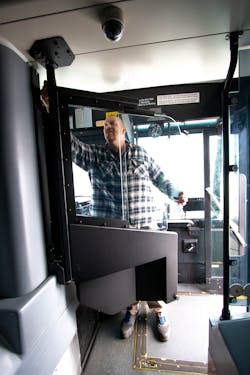For the past several years, there has been an uptick in assaults and violence against transit employees, specifically bus operators, which has been a growing concern for transit agencies across the country. Recently, a Detroit Department of Transportation bus operator was forcibly removed from her seat and attacked. And in May of 2019, a Hillsborough Area Regional Transit Authority (HART) bus operator was killed by a passenger while operating his bus.
In 2014, when this trend was first emerging, the Federal Transit Administration tasked the Transit Advisory Committee for Safety (TRACS) to develop recommendations on elements that should make up a Safety Management System (SMS) approach, which aimed to prevent and mitigate transit worker assaults.
TRACS came up with several recommendations such as installing safety shields, security cameras and automatic vehicle location systems; providing de-escalation training; and educating the public about reporting assaults.
Since these recommendations were published in 2015, many transit agencies, such as the Pinellas Suncoast Transit Authority (PSTA) and Palm Tran, have installed safety shields on buses and invested in new safety and de-escalation training to better safeguard their employees.
Equipment providing safe barriers
PSTA chose to invest $1.2 million from its capital reserve fund to install safety shields on 100 percent of its fleet, a first for the region, after HART Bus Operator Thomas Dunn was killed on his bus in PSTA’s neighboring county.
“We had been working with our employees and we had test modeled a safety shield for our bus about a year prior to the murder...and then that happened, and our employees came to me right away and said they didn’t feel safe,” said PSTA CEO Brad Miller. “So, we immediately fast-tracked a procurement and decided right then and there that we were going to have to give our employees peace of mind and put a shield on 100 percent of our fleet.”
Since PSTA had already been prototyping one option, employees had the chance to provide feedback on what they liked and didn’t like prior to the procurement. While there were pluses and minuses, Miller says PSTA employees went from a somewhat mixed review of the prototype to 100 percent supportive of it overnight following Dunn’s death. PSTA also conducted research on different models other agencies were using. By the end of May 2019, PSTA, along with HART employees, gathered to collectively decide on which safety shield they wanted.
“[The operators] were thankful we sought their input,” Miller said. “They gave a ton of input on exactly the design features in the shields that we ended up buying, so it’s been very positive since last January when we actually ordered them.”
The safety shield they decided on is a two-part shield from AROW Global that has an opaque solid bottom with a tempered, sliding glass window halfway up, which can extend from the back of the driver’s barrier to the fare box, completely walling off the operator from a customer. The sliding window allows for easier communication.
“It certainly limits the ability of a person to reach around and touch the operator in any way,” Miller said. “There’s no shield that can prevent everything, but this is what we as an agency all agreed was the best option.”
Palm Tran also plans to make a major investment in safety shields, or as they call them, “Operator Office Doors,” after receiving requests from bus operators due to concerns that someone that could physically touch them.
Palm Tran Executive Director Clinton B. Forbes explains the agency sent out a survey to get operator input, adding that Palm Tran will be installing the operator office doors this year.
“That’s a more than $1-million investment to install more than 160 operator office doors on our fixed-route fleet,” Forbes said. “[The operators] are excited about it.”
Adding safety tools to the operator’s toolbox
Equipment is just one aspect of ensuring bus operator safety. Palm Tran has seen a reduction in preventable, nonpreventable and passenger incidents, which Forbes credits in part to the safety culture that’s been established throughout the organization. Creating a safety culture that everyone buys into, in turn, creates a safer work environment for bus operators.
Forbes explains it started with communication by ensuring Palm Tran’s mission is aligned with safety and is ubiquitous throughout the organization. One way this is accomplished is through the monthly safety message, which serves as general safety reminders for best practices when operating a vehicle. Past safety messages have touched on how to approach railroad tracks, how to operate safely in a school zone and how to safely enter a gated community.
“A lot of these safety messages are driven by what we’re seeing out there,” said Joe Harrington, senior manager of public relations at Palm Tran.
Forbes adds how he believes bus operators have really bought into the safety messages.
“Some of the safety messages originate from bus operators,” Forbes said. “That’s how engaged they are; that they may suggest the next month’s safety message because of a trend they see out in the field.”
Once the monthly safety message has been established, it’s posted in every company room and is used to start every single meeting. At the start of a meeting, someone will read the safety message and reflect on how it applies to them.
“...By way of speaking about [safety] and always speaking about it, we speak it into existence,” said Palm Tran Director of Support Services Gilbert Morales.
The safety message is just one aspect of the safety culture at Palm Tran. In 2017, Pam Tran developed an agency-wide program, Palm Tran Statistic (PT STAT), that brings people together from different functional areas to develop, present and implement initiatives aimed at improving performance metrics. There are 10 PT STAT teams, some of which includes safety and accident reduction; reduction of rollcalls; on-time performance; and ridership. Forbes shares it’s created a lot of synergy and teamwork within the agency.
“We have an organizational philosophy that creates innovation and high performance, and not about the individuals, but about the team,” Forbes said. “I believe [in] creating a space and environment where everybody’s slices of genius can be unleashed and harnessed and turned into a work of collective achievements.”
One slice of genius came from the safety and accident reduction team, which developed a project called the Flashing Light Campaign. Cars were running into the backs of buses, so the team developed a project to retrofit all the buses with a flashing light to increase visibility and to improve nonpreventable accidents.
“We started this initiative with our fixed-route fleet and we’ve now extended that to include all our paratransit vehicles,” Harrington said. “Putting these flashing lights on the vehicles has really helped reduce the number of people who are running into the back of those vehicles.”
Other safety initiatives from PT STAT teams include reducing side swipes by adding reflective tape to the side rear of buses and reducing the number of wheelchair incidents by implementing a mandatory wheelchair securement policy.
“We’ve seen metrics really moving in the right direction,” Harrington said. “We’ve also seen a significant reduction in customer concerns, so the customers are happier too with the same service we’re providing.”
In addition to the safety message and the PT STAT teams, Palm Tran is providing de-escalation training to help bus operators deal with a range of difficult situations. Forbes explains that while, yes, accidents are a safety concern, another safety concern is carrying thousands of people each day.
“What we have been doing is putting more tools in the operator's toolbox,” Forbes said.
The de-escalation training takes place in a town hall setting and usually lasts 3-5 days to train the nearly 400 operators. It consists of going over techniques to deal with difficult situations and was started about four years ago. And the results speak for themselves.
“To [the] point on the number of customer concerns that have gone down, we believe that’s a direct indicator of that training we invested in,” Forbes said.
Palm Tran isn’t the only agency to implement de-escalation training. PSTA also invested in de-escalation training for nearly 400 bus operators following the installation of the safety shields. Miller explains PSTA saw this training as a way to reduce altercations related to fare payments.The training gives operators techniques on how not to escalate concerns about fare payments or how to read the temperature of a situation so nothing bad happens.
“I think that has been very effective,” Miller said. “I know our employees like that.”
By investing in safety, agencies invest in results
Investing in equipment and safety training creates a safer work environment for bus operators and a safer commute for passengers. Transporting thousands of customers a day means there’s thousands of interactions a day, some of which may be difficult. By giving operators the necessary tools to deal with these sometimes-difficult situations, agencies will start to see clear improvements.
“Safety is in our DNA and we’re starting to really see the results of that,” Forbes concluded.

Megan Perrero | Editor in Chief
Megan Perrero is a national award-winning B2B journalist and lover of all things transit. Currently, she is the Editor in Chief of Mass Transit magazine, where she develops and leads a multi-channel editorial strategy while reporting on the North American public transit industry.
Prior to her position with Mass Transit, Perrero was the senior communications and external relations specialist for the Shared-Use Mobility Center, where she was responsible for helping develop internal/external communications, plan the National Shared Mobility Summit and manage brand strategy and marketing campaigns.
Perrero serves as the board secretary for Latinos In Transit and is a member of the American Public Transportation Association Marketing and Communications Committee. She holds a bachelor’s degree in multimedia journalism with a concentration in magazine writing and a minor in public relations from Columbia College Chicago.


